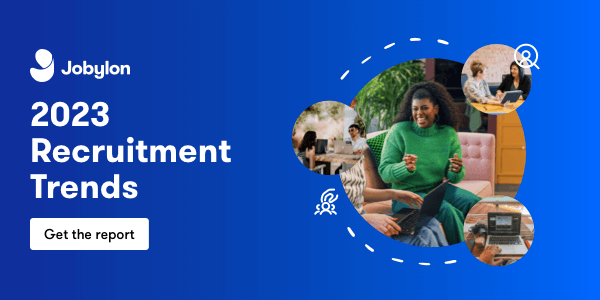With new technology being developed every day, research revealed that about 33% of jobs in the US are at risk of becoming obsolete by 2030. While this is the case, another study showed that 97 million new roles driven by this digital transformation are expected to be created. For this reason, the need for highly skilled employees is more important than ever, so companies can adapt to this ever-changing environment in 2023 recruitment trends.
With economic uncertainty causing companies to reduce their number of new hires, it is more important than ever for employers to take advantage of internal mobility to retain their existing talent. To combat this challenge, employers must make the most of the skills their current employees possess by providing opportunities for upskilling and reskilling.

The case for Upskilling and Reskilling
The evolution of existing jobs and the emergence of new roles demand new and advanced capabilities, creating skills gaps in the current workforce. Upskilling and reskilling your workers can bridge this gap without having the need to hire new employees in the hopes of acquiring the skill set needed by your company.
Investing in your employees' development will not only arm them with the skills to stay competitive in the future, but also show that your company values them and their career ambitions. With a strong focus on development, you can ensure that your employees become lifelong learners and are ready to take on any challenge the future of your business brings.
Differences between Upskilling and Reskilling
Upskilling involves training your employees to expand their existing knowledge and skill sets. This will allow them to adapt to the changes in their job requirements and continuously advance in their current career path while contributing more productively to your business. On the other hand, reskilling means providing your workers with development opportunities that will equip them with the new sets of skills needed to take on a new role different from their current career direction. This process will enable top talents with limited growth opportunities in their current role to reposition themselves in your company. This will also help you retain valuable employees who have already proven their worth but cannot be in the same role.
Supporting workers to advance in their careers is a huge opportunity for employers. Not only will it make your current workforce more efficient and productive in their jobs, but it can also become an effective strategy for employee recruitment and retention. As a result, you can save approximately one-half to two times the employee’s annual salary in employee turnover. Ultimately, this can be a great way to build a stronger employer brand. Because when your employees feel a sense of purpose with your company, they are more likely to recommend you to their personal and professional network. Thus, allowing you to attract new diverse talents. In this article, we will share our best strategies to upskill and reskill your workforce so you can benefit from what these processes have to offer.
1. Conduct skills gap analysis
Industries are rapidly changing, and so are the skills required to stay at the top of the game. Therefore, companies need to adapt at the same pace not to fall behind and remain competitive and relevant in their industries. Hence, they should constantly assess if they currently have the skills to do so. This is where skills gap analysis can be beneficial. Doing this can help you gain insights into your entire workforce and determine the important skills gap you need to address to meet your present and future goals.
To do this effectively, we suggest having a deeper understanding of your company values as well as your business objectives, future goals, and current performance. This way, you can figure out the must-have hard and soft skills to accomplish new projects or strategic initiatives. Then measure the capabilities your workforce currently possesses. You can do this through surveys, tests and assessments, and interviews. Doing this can also help you identify who may have or need the skills among them. Thus, allowing you to better target your training resources and plan your upskilling and reskilling strategies towards the skills and people that will truly contribute to the business in the long term.
2. Give employees the freedom to own their career development
We believe that the success of upskilling and reskilling your workforce relies on whether or not your chosen employees are invested in them. In most cases, they already know what they want to learn more about or accomplish more in their careers before joining a company – they’re just not sure where or how to get started for them to get there. Hence, focusing on their professional interests and putting them in charge of their own career development can help them become more motivated and engaged to learn additional or new skills, making the process of upskilling and reskilling more effective.
However, while empowering them to reach their own career path is important, you also have to ensure that it is relevant to the business. Be intentional about how you approach the process and have clear objectives for your employees. Also, be transparent about the knowledge or skills they are required to have to meet your business needs. For example, if one of your employees has been offered the chance to reskill for an upcoming project, make sure to clearly communicate this with them. Let them know how you’ll support them in identifying opportunities for career advancement that are not only critical to the business but also align with their career passions.
3. Accommodate different learning styles
Different people learn differently. The same is true when it comes to upskilling and reskilling employees. Some employees will lose interest in a traditional classroom setting, but some will excel with their interesting remarks and questions. Some can learn fast by just reading and listening, but some prefer a hands-on approach or practical simulation. Hence, it is important to have a deep understanding of which learning style works best for each employee so you can provide them with the training they need in a way that they will really benefit from it.
When planning your upskilling and reskilling, it is imperative to keep in mind that what works for some employees may not work for others. So, to accommodate their different learning styles, make sure to offer different training methods. In addition to the traditional approaches, such as presentations and instructor-led training, we suggest including more modern ones like webinars, e-learning courses, virtual classrooms and simulations, games, and other formats that can make learning more fun and exciting. By doing this and letting your employees decide where they can excel during the upskilling and reskilling can help you maximize engagement and participation.
In addition, providing a variety of learning styles can help you ensure that the opportunities are available and accessible for all your employees, allowing them to learn at their own pace. For example, e-learning courses offer employees the opportunity to learn wherever and whenever convenient, which is especially useful if you have a remote or hybrid workforce. More importantly, this learning style enables them to review the materials as many times as they need and focus on the areas where they need the most support. As a result, employees can retain information and master the new required skills more quickly.
4. Reward employees in turn for their upskilling or reskilling efforts
Employee rewards and recognition are part of any company’s internal strategies. These help employees feel more engaged, motivated, valuable, and productive. For this reason, we suggest including rewards in the overall strategy for upskilling and reskilling your workforce. These can include incentives, certificates of recognition, achievement badge, or just a simple acknowledgment from one of your executives. Doing this will not only help you reinforce the importance of upskilling and reskilling, but it can also be a great strategy to promote continuous learning because employees can see that their efforts are recognized and appreciated.
5. Evaluate and refine continuously based on changing needs
The new world of work requires employees to continuously hone their knowledge and skills. Hence, upskilling and reskilling should be an ongoing process with an aim to empower employees to reach their full potential, adapt to ongoing demand for new skills, and grow with the company. So as technological advancement and societal shifts continue to disrupt the status quo, it is important to refine your strategies based on the ever-changing needs of the business.
To do this effectively, we recommend evaluating the outcomes of your upskilling and reskilling strategies periodically. This way, you can measure their overall effectiveness and recognize areas for improvement. Thereby allowing you to make relevant changes where necessary and better align them with the needs of the business and your employees. In turn, you can cultivate an environment of continuous learning that is more responsive to the rapidly changing needs of your company.
Conclusion
Upskilling and reskilling are essential for organizations to thrive in an ever-changing business environment due to continuous automation and digital transformation. So, to remain competitive, it is crucial to invest now in the development of employees and build a culture of lifelong learning more than ever. By creating the right environment and encouraging your employees to take advantage of these available learning opportunities, you can reap the benefits of a highly motivated and engaged workforce that is well-prepared for the future of work.
Make sure to download our 2023 Recruitment Trend Report for the in-depth insights and how you as a hiring manager can utilize these to maintain a competitive advantage throughout 2023 and beyond.





